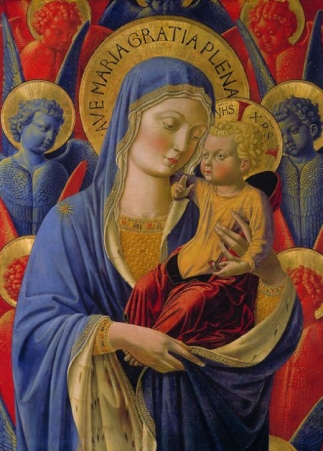 |
During the excesses of the Christian witch hunts of 16th and 17th Century Europe, left-handedness was considered hard evidence of demonic possession and witchcraft (witches were supposed to use their left hand to curse people), and may actually have contributed to the untimely deaths of many innocent women.
But the Church’s right-handed bias has also shown itself in some more subtle ways. It is claimed that, up until the Renaissance, religious paintings of the Madonna and Child almost always showed the Child being held on the more traditional left side. After about 1450-1500, however, there was an almost complete reversal, with the vast majority of paintings showing the Madonna holding the Child in her right arm.
The Bible of Christianity and Judaism is full of positive references to the right side and the right hand, and negative references to the left (by some counts, over 100 favourable references to the right hand and 25 unfavourable references to the left). There are many passages describing the position of privilege on God’s right hand, and several others indicating the preferential position of the right. Psalm 188 begins, in no uncertain terms, “The right hand of the Lord is exalted; The right hand of the Lord doeth valiantly”. Another well-known example is the parable in the Gospel of Matthew of a shepherd separating the sheep from the goats, where the sheep on the right are the blessed who will inherit the kingdom of Heaven, and the goats on left are cursed to everlasting damnation with the Devil and his angels.
The only even vaguely positive reference (albeit not a particuarly honourable one) occurs in the Book of Judges, where the assassin Ehud uses his (unexpected) left-handedness to kill the king of Moab and thereby release the Israelite tribes from Moabite domination. For this Ehud became celebrated as a Jewish hero, and he regularly appears in lists of famous left-handers.
There are many similar passages exalting the right hand in Islam's holy book, the Qur’an. In both Islam and Hinduism, the right hand is generally reserved for honourable occupations such as food handling and ceremonial activities, while the left hand is specified for necessary but unclean purposes such as cleaning oneself after defecation. The use of the left hand for ceremonial purposes is therefore severely limited and, in many religious Asian countries, the offering and acceptance of gifts is conducted exclusively with the right hand. In Buddhism, the right-hand fork in the path is the one that leads to Nirvana, while the left hand fork is to be rejected.
Within the magic fraternity of modern witchcraft and Wicca, Black Magic, which draws on malevolent powers and is used for dark purposes or for the advancement of the self, is sometimes referred to as the “Left-Hand Path”, while White, or good, Magic is the “Right-Hand Path”, stressing spirituality and observance of the moral code and the worship of deities. The left hand plays a leading role in many Satanist ceremonies (as do anti-clockwise rituals), not because of any particular belief in its inherent qualities, but largely in deliberate contradiction to the practices of most other religions.
The left hand does have some few positive connotations in some religions. In Tantric Buddhism, for example, the left hand represents wisdom. Among the ancient Incas (and some of their modern-day descendants) left-handers were believed to possess special spiritual abilities, including magic and healing.
Research has shown that left-handers, and particularly mixed-handers, are likely to be more susceptible to superstition, belief in the paranormal, religion and magical thinking in general, usually referred to under the general term, “magical ideation”. It has been hypothesized that this link may be connected to the possible link between mixed-handedness and schizophrenia (see the section on Handedness and Health), schizophrenics often havinge difficulty distinguishing reality from delusions.
